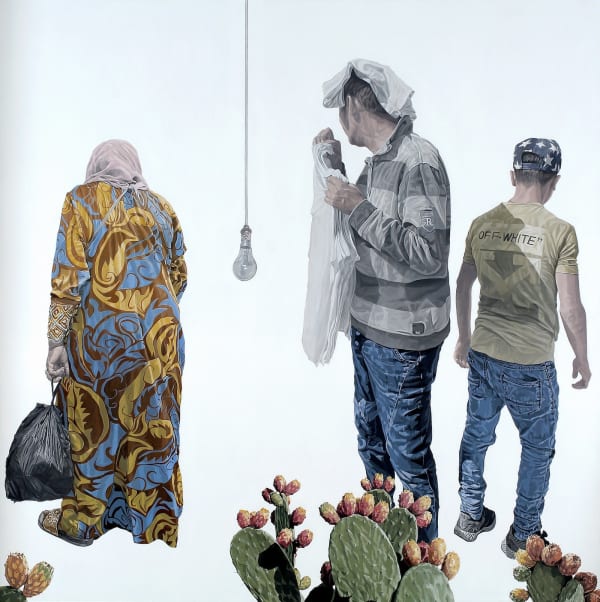Atef Maatallah El Fahs, b. 1981
Atef Maatallah was born in 1981 in Al Fahs, Tunisia, a town that is at the heart of his work. Revisiting the codes of narrative figuration in his paintings, drawings and mosaics, Atef Maatallah dissects reality through the representation of images of ordinary life, haunted by characters that the artist meets, scattered with allegoric details and symbolic elements. By guiding our gaze, Atef Maatallah's compositions change our relationship with the visible, they overturn hierarchies, they spur contemplation. By bridging seen and unseen realms, his intimate history and that of his native land, his work mingles the themes of death, sensuality, the spiritual.
Atef Maatallah graduated from the Institut Supérieur des Beaux-arts of Tunis and pursued his training at the Cite des arts de Paris. Since in 2010, he has widely exhibited in Tunisia and abroad, represented by Elmarsa Gallery in Tunis and Dubai, as well as at international art fairs in Dubai, Abu Dhabi, London, Marrakech, Paris and New York. In 2012, he became a member of the artist collective Politics. In 2014, Atef joined the artist collective Zamaken, well-known for its art monumental installations in the public space. His work has been included in various group shows including at the Institut des Cultures de l'Islam de la Ville de Paris in 2016, Me.Na Pavilion in Singapore in 2014 curated by Catherine David from the Centre Pompidou, and he was twice the recipient of the Prize of Paris Contemporary Drawing in 2015 and 2016. The same year, he completed a one-year residency at the Cité Internationale des Arts de Paris. He was selected to be part of Phaidon's publication Vitamin D3 (2021): Today's Best in Contemporary Drawing. Between 2021 and 2022, he executed a 90 square meters mural painting "The Builders" commissioned by the cultural association 32Bis for the façade of its building in Tunis. His works have been acquired by various private and public collections in North Africa, Europe, the United States and the Middle East, including Barjeel Art Foundation, Kamel Lazaar Foundation and the Ministry of Culture in Tunisia. Atef Maatallah lives and works in Tunis.
Mohamed-Ali Berhouma: Archaeographing the interior lands. Some incursions into Atef Maatallah's drawings.
When the words were silent, the studio was filled with the rustle of the stones. Not only the figurative stones, the ruined stones, but their resonance in the practice of drawing: the graphite pencil leads. They are also stones whose erosion tells a story. The rubbing of the pencil lead on the paper seemed to be the scansions of a long poem, punctuated by stops: the choice of another lead, sometimes fatter, loaded with graphite, sometimes drier, loaded with clay. And each pencil, each lead refill and each level of erosion of the tip points made a singular noise. On the surface of the paper, graphite stones and their wear and tear echoed faithfully the ancient stones and their defeats on the surface of history. Even more than seeing the drawings being made, entering the artist's graphic monuments also involved listening to the eroding graphite ores.
At first sight, the first graphic fields, which we witnessed being created during our visits, state the interference of two different times: on the one hand, the time of History - already established by its capital initial -, borrowing its slowness and powers from the resistance of the stone, from the persistence of ruin; a time that then intended to be timeless, erecting its temples and carving its monuments towards an eternity by which its men would attain immortality. On the other hand, it is also the time of history - announced, this one, by its anecdotic lowercase -, being part of the transitional and fleeting course of a daily life, of the banal flight of a plastic bag, of the ballet of drying clothes. The time of a mezoued⁷ melody that spreads its complaints to the four winds, of the vulgarity of a garbage lying on the ground. Despite their apparent distance, these two times coexist together and in the same time: that of the work; two times whose strange encounter establishes the poetic power of these visions. […]
Mosaic:
Alongside the drawing, another work in progress begins: the opus tesselatum. From now on, it was no longer just a question of drawing, of putting by erosion the stone on paper. Participating in the Antika also meant laying the stone itself, in the way that it adorns the floors of an antiquity, in the way that it arranges the ornaments of the imaginaries of that time. In the mosaic, one tessera after another, the patterns of the time of men and gods are posed for an eternity. Undoubtedly, it was this mineral eternity that inspired the artist to write on it the patterns of a transient. A can of beer, a pack of cigarettes or a few marbles, visions that do not know how to last, are emblematized to participate in the persistence of the stones.




